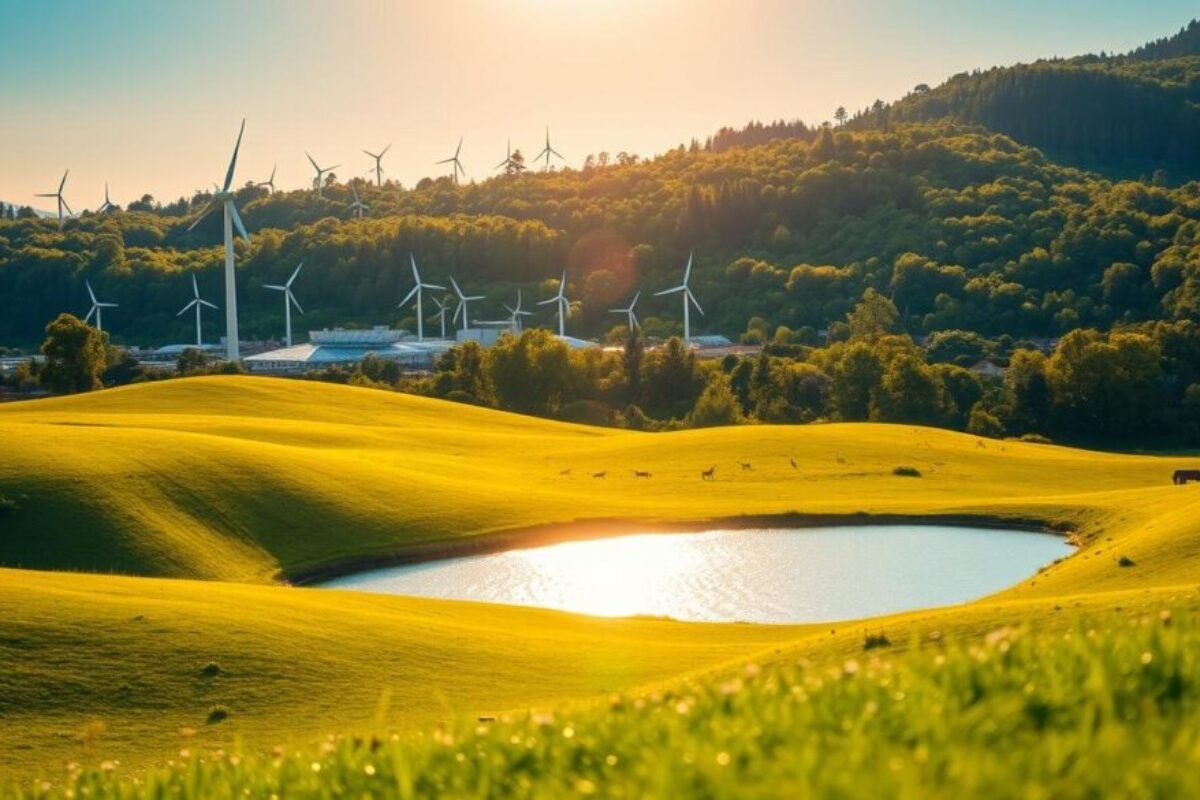Balancing Economy and Environment: Key Insights
Did you know the global economy could lose up to $2.5 trillion a year because of climate change? This is a big problem, showing we need to look closely at how the economy and environment are connected. As we try to grow our economy, we must also think about how to protect our planet.
Now, moving towards a green economy is not just good, it’s necessary. We need to change how we think about growing our economy. We must find new ways that help both our wallets and the planet. With climate change causing problems like extreme weather and fewer resources, we must plan for the future carefully. By understanding these issues, we can create an economy that cares about both money and the environment.
Key Takeaways
- The economic impact of climate change could reach $2.5 trillion annually.
- We must address sustainability challenges to ensure future economic stability.
- A green economy is essential for balancing growth and environmental protection.
- Understanding climate change is critical for effective planning.
- Environmental stewardship should be integrated into economic models.
Understanding the Green Economy
The green economy is key in talks about sustainable growth. It links economic actions with caring for the environment. This system aims to grow while reducing harm to nature, helping us live in harmony with the planet.
Definition and Importance
A green economy focuses on bettering human lives and fairness while cutting down environmental dangers. It blends sustainability into economic plans. It shows that using renewable energy and sustainable farming is essential for lasting success.
By supporting a green economy, we tackle big economic and environmental challenges. This opens the door to practices that help both people and the Earth.
Role in Sustainable Development
The green economy is essential for sustainable growth. It pushes for new solutions that grow the economy and protect nature. Supporting a green economy means more jobs in new fields, helping the economy and the environment.
This approach leads to a fairer future. It makes sure sustainability is part of our daily lives.
Current Economic and Environmental Issues
The world today shows how climate change affects both our planet and our money. As the weather changes, we see big effects on nature and our economy. It’s key to understand these links to tackle the problems of not enough resources and shaky economies.
Impact of Climate Change on Economic Stability
Climate change is a big threat to our money. Bad weather causes damage and stops things from working, making fixing things very expensive. Over the last ten years, these costs have doubled, showing we need to act fast.
Without action, climate change will keep changing how we spend money. It will make it hard for governments and businesses to keep up.
Resource Scarcity and Economic Growth Challenges
Not having enough resources is a big problem for growing our economy. Countries that rely a lot on oil and gas are at risk. They can’t keep growing because they don’t have enough to use.
We need new ways to use resources better and not rely so much on them. This way, we can grow our economy without hurting the planet.
Sustainability Challenges in Modern Economies
The mix of economic growth and protecting the environment is a big challenge today. We need good strategies to deal with these issues. Economic growth helps us grow, but it can harm the environment.
Industries often don’t want strong environmental rules. This makes it hard to reach our sustainability goals. It’s not just about following rules; it’s about fairness in using sustainable ways.
Balancing Economic Growth with Environmental Protection
We need to find a way to balance economic growth and protect the environment. Our ways of managing energy, using resources, and reducing waste must change. We should use green practices that don’t hurt our economy.
We should look for new ways to grow our economy while taking care of the environment. This way, we can have a strong economy and a smaller ecological footprint.
Addressing Inequalities in Sustainable Practices
One big challenge is making sure everyone has equal access to sustainable practices. Not everyone can use green technologies and resources. This affects some groups more than others.
We need to make sure everyone can join in on sustainable efforts. This way, we can make our future fairer and greener for everyone.
The Role of Renewable Energy Solutions
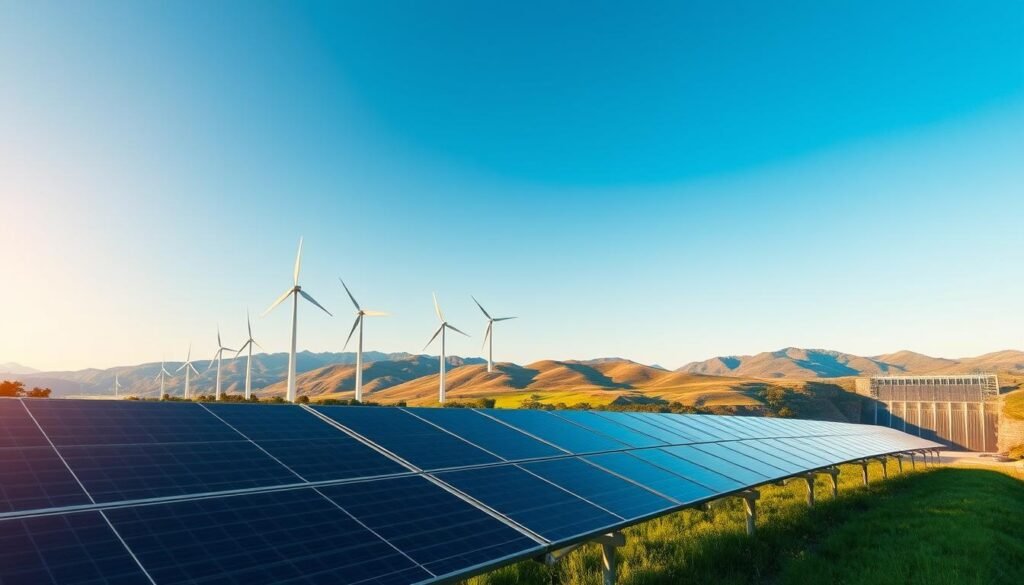
In our quest for a sustainable future, renewable energy is key. It leads to innovation and opens up economic chances. Solar and wind energy, in particular, fight climate change and boost economic growth.
Advancements in Clean Technologies
New breakthroughs in clean tech have changed how we get energy. Solar panels now work better, and wind turbines have improved. This shows our dedication to using less fossil fuel.
These changes make clean energy more accessible and powerful. As we add these to our systems, we create a strong base for clean energy in our lives.
Economic Benefits of Renewable Energy Initiatives
Renewable energy brings many economic gains. It creates jobs in making, setting up, and fixing these systems. This helps local economies grow.
Clean tech is also cheaper than old energy sources. It saves money for homes and businesses over time. Plus, it makes the air cleaner, cutting down on health costs. This shows the big wins of choosing sustainable ways to grow the economy.
| Benefit | Description | Impact |
|---|---|---|
| Job Creation | New jobs in the solar and wind energy sectors | Increased employment rates and economic stimulation |
| Cost Savings | Lower energy costs for consumers | Improved financial sustainability for households |
| Health Improvements | Reduction in air pollution | Lower healthcare expenses and improved public health |
| Environmental Impact | Decreased carbon footprint | Greater resilience against climate change |
Strategies for Economic Sustainability
For economic sustainability, we need a big plan. We can make policies that help the green economy and solve environmental problems. This way, we build a strong base for lasting growth and change.
Policies for Promoting a Green Economy
Strong policies are key to a green economy. We can use things like carbon pricing and tax breaks for green energy. Governments must help by making rules and supporting businesses in going green.
Long-term Economic Sustainability Plans
Our plans for the future must focus on new ideas and working together. By teaming up with local people, we can create plans that work. Investing in green tech and infrastructure helps our economy stay strong for years to come.
Social Responsibility in the Business Sector
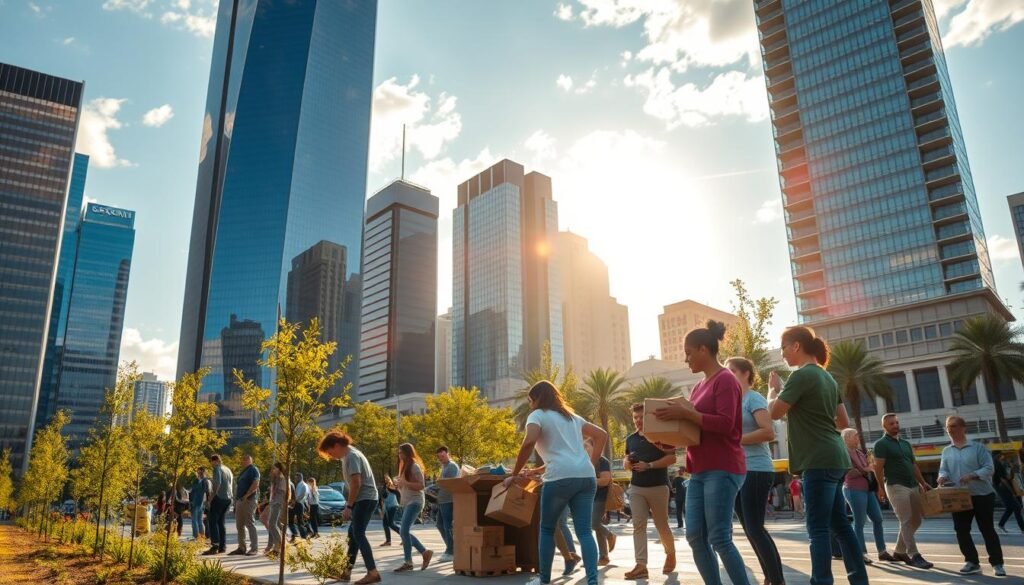
Businesses today must focus on social responsibility to meet modern expectations. This means doing more than just making profits. It’s about creating social benefits and supporting sustainable development. This way, companies build stronger relationships with their stakeholders and become more resilient in the long run.
Importance of Corporate Social Responsibility
Corporate social responsibility (CSR) greatly affects how people see a company. When businesses put CSR first, they show they care about society. This makes them more appealing to customers who value ethics and align with their values.
Also, employees tend to stay longer and are happier when they work for companies that help society. This is because people want to be part of something positive.
Examples of Effective Social Responsibility Practices
Many companies have made social responsibility a key part of their work. For example, Patagonia uses recycled materials and supports environmental causes. Unilever has started projects to improve health and well-being in communities.
These actions show that being ethical can be good for business. They also help the environment and society a lot.
| Company | CSR Initiative | Impact |
|---|---|---|
| Patagonia | Recycled Materials | Reduced waste and environmental impact |
| Unilever | Community Health Programs | Improved health outcomes and local engagement |
| Ben & Jerry’s | Climate Advocacy | Increased awareness about climate change |
| Starbucks | Ethical Sourcing | Support for sustainable farming practices |
Environmental Policy Analysis
We need to understand how environmental rules affect economic growth. A deep analysis shows how regulations drive innovation and set pollution and resource use standards. While some rules help businesses be more sustainable, the gap between policies and needed actions slows progress. This gap is a big challenge that needs quick action.
Key Regulations Impacting Economic Growth
Regulations shape the economic growth landscape. The Clean Air and Clean Water Acts are key to keeping environmental standards and encouraging businesses to follow them. These rules push companies to innovate in reducing pollution. This helps them stay competitive and grow the economy while caring for the environment.
Assessment of Current Environmental Policies
We must look at how well current environmental policies work. These policies aim to tackle big sustainability issues, but their success varies. For instance, policies to cut carbon emissions might face political hurdles or a lack of funds. We see forward-thinking policies and those that don’t keep up with environmental changes.
| Policy Type | Success Rate | Challenges Encountered | Impact on Economic Growth |
|---|---|---|---|
| Emission Standards | High | Compliance Costs | Positive |
| Incentives for Renewable Energy | Medium | Market Fluctuations | Promotes Growth |
| Water Quality Regulations | Low | Lack of Enforcement | Negative Impact |
Our analysis shows where we need to improve policies. By seeing how economic growth and sustainability go hand in hand, we can push for better policies. Through ongoing review and change, we can tackle challenges and seize opportunities that help both the economy and the environment.
Impact of Climate Change on Industries
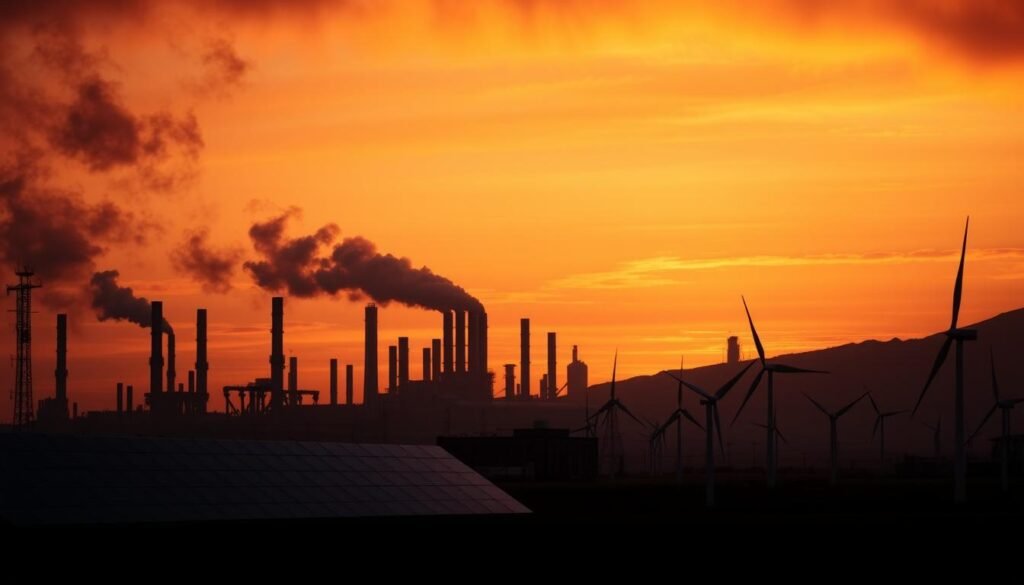
Our economy is changing, and so is the impact of climate change on industries. Industries like oil and gas face big challenges. They must adapt to new environmental rules and changing markets.
These sectors need to change how they work. They’re looking for new ways to do things.
Challenges Faced by Carbon-Intensive Industries
Carbon-intensive industries are facing big problems. Governments are making rules to cut down on greenhouse gases. This makes things more expensive and requires a lot of money for new technology.
People are also wanting more green products. This means old industries must find new ways to stay relevant. They need to move away from fossil fuels or lose customers.
Opportunities in Emerging Green Sectors
But, there are also chances for growth in green sectors. The move to a cleaner economy is creating new jobs and opportunities. Companies that get on board can lead the way.
New tech and partnerships can help businesses grow. This shows that going green can actually help the economy grow, too.
Global Environmental Challenges and Economic Implications
The world is facing big environmental challenges that need global cooperation. Countries are dealing with climate change, resource loss, and biodiversity decline. Working together is key to solving these problems and thinking about the future economy.
By teaming up, we can tackle these issues better. This way, we not only protect the environment but also think about the economy’s future.
International Cooperation for Sustainability
International cooperation is essential for solving global environmental problems. The Paris Agreement shows how countries can work together on climate goals. By sharing technology and knowledge, we can make sustainability efforts more effective.
These partnerships help us use resources wisely. They also help balance the costs of moving to a greener economy.
Case Studies of Effective Global Partnership
Many examples show how global partnerships can succeed in environmental issues. The European Union and African countries are working together on sustainable farming. This improves food security and uses eco-friendly methods.
In South America, countries are teaming up to save the Amazon rainforest. These partnerships show how working together can lead to good solutions for the environment and economy.
| Partnership | Focus Area | Outcomes |
|---|---|---|
| EU-Africa Collaboration | Sustainable Agriculture | Enhanced food security and eco-friendly practices |
| Amazon Preservation Pact | Forest Conservation | Reduction of deforestation and biodiversity protection |
| Asia-Pacific Clean Energy Initiative | Renewable Energy Development | Increased investment in green technologies and job creation |
Green Economy Solutions and Their Effectiveness
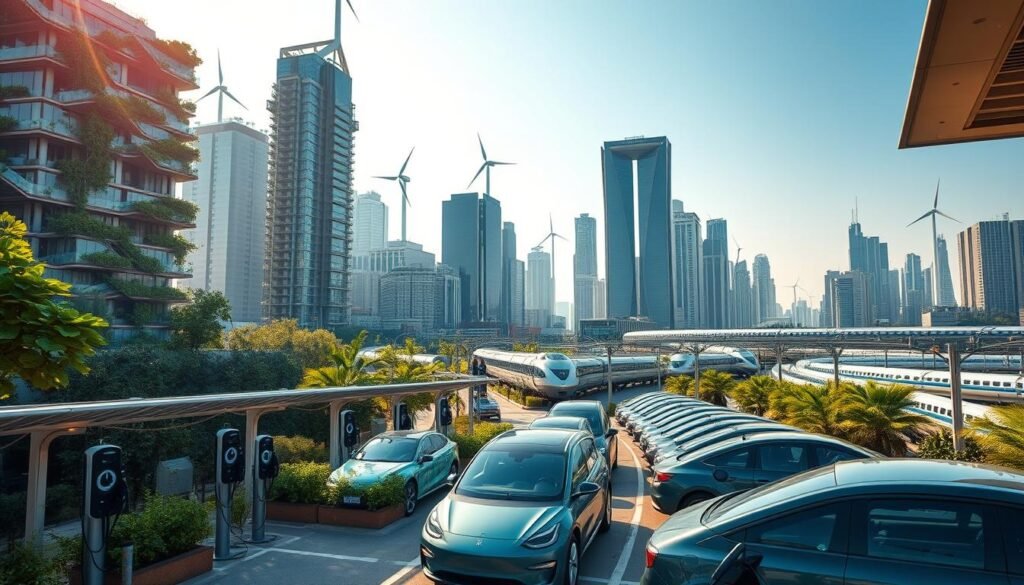
Innovative green economy solutions tackle global environmental and sustainability challenges. By using effective strategies and policies, countries are moving towards a sustainable future.
Innovative Approaches to Environmental Conservation
Countries using creative green economy solutions show great success in saving the environment. These methods not only cut down on carbon emissions but also boost the economy. Here are some examples:
- Germany’s Energiewende: A nationwide effort to use more renewable energy, cutting down on fossil fuels.
- Costa Rica’s reforestation programs: These programs have helped grow forests and increase biodiversity.
- Sweden’s sustainable transportation policies: By investing in electric transport and cycling, Sweden has lowered emissions and improved air quality.
Success Stories from Various Countries
Looking at success stories shows how good policies help the green economy. Countries like Denmark and New Zealand share practical solutions. Here’s a table showing some initiatives and their effects on sustainability:
| Country | Initiative | Impact |
|---|---|---|
| Germany | Transition to Renewables | Over 40% of electricity from renewable sources |
| Costa Rica | Social Forestry Program | Increased forest cover to over 50% |
| Denmark | Wind Power Expansion | Generated 47% of electricity from wind turbines |
| New Zealand | Conservation Efforts | Protected numerous native species and habitats |
Measuring Progress in the Green Transition
As we move toward a sustainable future, measuring progress is key. We use the right tools to check how well green practices are working. This helps us see what’s working and what needs tweaking.
Tools and Metrics for Success
Measuring progress involves both numbers and words. Here are some important tools:
- Environmental Impact Assessments – These help us see how projects affect nature, guiding our choices.
- Carbon Footprint Calculators – They show how much we’re emitting and how to cut down.
- Benchmarking Reports – These studies compare us to others, showing how we stack up.
- Sustainability Indices – They give us a visual of our green efforts, pointing out what needs work.
Identifying Barriers to Implementation
Even with the best plans, obstacles can slow us down. It’s vital to know what’s holding us back:
- Financial Constraints – Not enough money can block new tech and practices.
- Lack of Technical Expertise– Without the right skills, we can’t make sustainable changes work.
- Regulatory Challenges – Too many rules can slow down green efforts.
- Resistance to Change – People’s hesitation to try new things can also be a hurdle.
By understanding these challenges, we can make our path to a greener economy smoother. This will help us build a sustainable and strong future for everyone.
Conclusion
Let’s face it, balancing economic growth with environmental care is a big deal. It’s something we all must do. By adopting green economy practices, we can tackle big problems that affect our future.
We need to work together and include everyone in this effort. This means businesses and policymakers must join hands. Together, we can make sure our planet stays healthy while our economy grows.
It’s up to us to find solutions to our economic and environmental problems. Let’s support the green economy and choose sustainable ways of living. With teamwork, we can turn challenges into chances for a better tomorrow.
